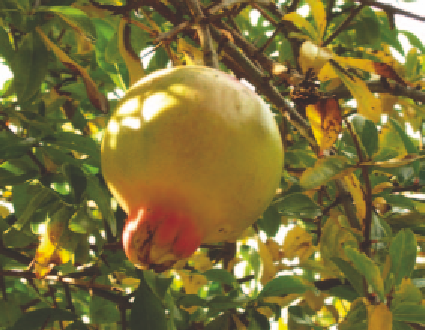Agriculture Reference
In-Depth Information
buds are generated mainly on one-year-old
wood that can be shortened to encourage
spur growth after harvest or left to develop a
replacement branch. In espaliered trees
shorten side growth to six leaves in spring and
back to three after harvest.
Fruitthinning
Almost all plums need fruit thinning to
reduce the burden of the crop. The European
plum is slightly smaller than the Japanese so
thin to 5 to 7 cm spacings. Japanese plums
are best at 7 to 10 cm spacings. Thinning by
hand can be tedious; hitting the branches
with a rubber hose-tipped stick is much more
satisfying, if less accurate.
Figure 6.32
Pomegranates flower and fruit on short
shoots or spurs near the ends of branches.
Pomegranates sucker freely which can be an
advantage in very cold climates if the shrub is
grown on its own roots, but generally it is just
a nuisance, robbing the main plant of vigour.
Remove all suckers as soon as you see them
(see page 46, 'Suckers'). Always purchase a
named variety as they vary widely in quality
and do not come true from seed. The dwarf
pomegranate
P. granatum nana
is truly
revolting to eat, no matter how ornamental.
Harvest
Plums are best straight from the tree. When
they are fully coloured for their cultivar and
showing just a touch of softness, gently twist
them off.
Pomegranate
Punicagranatum
Pomegranates may not be an essential food
but their gnarled beauty and fantastic fruits
make them a treat for the landscape as well as
the table. This shrubby tree, deciduous in
cool climates but evergreen in warmer parts,
adapts willingly to many soil types. They will
even survive very frosty areas. In regions
where the temperature does not go below -5
to 7°C, it is best trained to a short trunk with
four or five main branches. A multi-stemmed
tree is the best approach in really cold areas
because if one trunk is killed by frost, there
are others left to continue.
Fruitingwood
Pomegranates flower and fruit on short shoots
or spurs near the ends of branches. These
remain productive for three to four years, after
which time they should be cut to a younger
side branch to renew the fruiting wood.
Pruningtime
Winter is a good time to assess the shape of
your plant and perhaps remove a very old
branch that is no longer productive. This will
stimulate new growth. Select the most robust
as a replacement branch. Pruning the four- to

